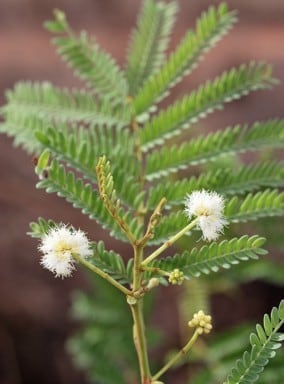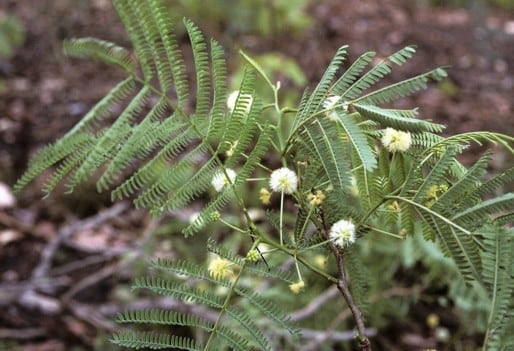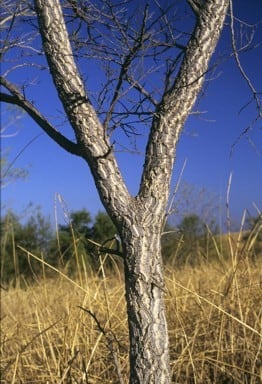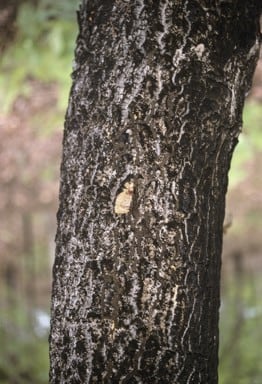Vachellia pallidifolia (Tindale) Kodela
WATTLE
Acacias of Australia
Family
Fabaceae
Distribution
Occurs in N.T. S from near Darwin to the Victoria R. region, c. 15°45'S.
Description
Tree 4–9 m high. Bark corky, fissured. Branchlets glabrous; younger branchlets often puberulous. Stipular spines 0.5–1.5 mm long, often inconspicuous or absent, to 10 mm long on young growth. Leaves: petiole 0.8–2.2 cm long, ±glabrous to puberulous or pubescent, mostly with a prominent gland at base of or just below lowest pair of pinnae; rachis (3.7–) 6.5–17.5 (–22) cm long, ±glabrous to puberulous or pubescent, mostly with a prominent, often broadly obovate gland at apex and sometimes at base of second pair of pinnae from apex; pinnae 6–18 pairs (often subopposite), 4–8 (–11.5) cm long; pinnules 13–34 pairs, oblong to narrowly oblong, lanceolate or elliptic to narrowly elliptic, sometimes slightly curved, (2.5–) 5–12 mm long, 1.5–3.5 (–4) mm wide, discolorous, glabrous or ciliolate-ciliate, with midnerve and lateral nerves visible and raised above. Inflorescences 1 or 2 in axils, simple or on a short axis which sometimes extends as new growth; peduncles (7–) 25–43 mm long, with involucel of bracts 1/3–1/2 way from base; heads globular, 16–23-flowered, cream-coloured to pale yellow. Pods slightly constricted between some or all seeds, ±flat except slightly raised over seeds, 8–13 (–17.5) cm long, 15–22 mm wide, coriaceous to thinly woody, longitudinally and obliquely nerved forming a ‘V’ pattern, almost glabrous or puberulous mainly along margins.
Phenology
Flowers recorded Sept. & Oct. Fruits Mar.–Oct.
Habitat
Grows in open forest, open woodland, low open woodland with grassy understorey and grassland, in chocolate brown soil, gravelly clay soil, rocky limestone soil, sandy red soil and alluvium, near watercourses, on drainage flats, sandstone outcrops and in undulating topography.
Specimens
N.T.: near Gerowie Ck, S.T.Blake 17166 (BRI, K); Arnhem Hwy, W of Point Stuart T/O, I.D.Cowie 352 (BRI, DNA, NSW); c. 60 miles [96.6 km] NE of Maranboy Police Stn, M.Lazarides & L.Adams 99 (BRI, CANB, DNA, K, L, MEL, NSW, US); Kakadu Natl Park, 25.2 km S along Snake Plain track from the road running W from Kakadu Hwy towards Black Springs, A.V.Slee, L.A.Craven & K.Brennan 2903 (CANB, NSW); c. 65 km W of Victoria R. on the Victoria Hwy a few km from Dingo Springs, M.D.Tindale 10122 et al. (DNA, NSW, PERTH).
Notes
Confusion concerning the interpretation of the type of A. pallida, hence the application of the name A. pallidifolia, is discussed by P.G.Kodela & P.G.Wilson, Telopea 11: 240 (2006); see also note under V. valida.
Based on molecular and other data Acacia sens. lat. is now considered as comprising a number of segregate genera, see J.T.Miller & D.S.Seigler, Austral. Syst. Bot. 25: 217-224 (2012) for overview. Many taxa in the former Acacia subg. Acacia are now referable to the genus Vachellia, including the one presented here.
FOA Reference
Data derived from Flora of Australia Volumes 11A (2001), 11B (2001) and 12 (1998), products of ABRS, ©Commonwealth of Australia
Author
P.G.Kodela
This identification key and fact sheets are available as a mobile application:
URL: https://apps.lucidcentral.org/wattle/
© Copyright 2018. All rights reserved.















